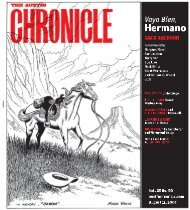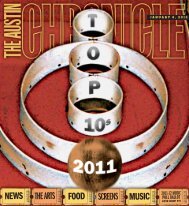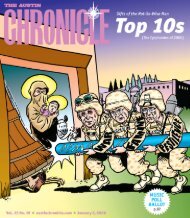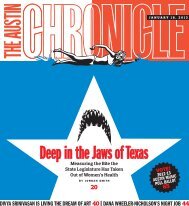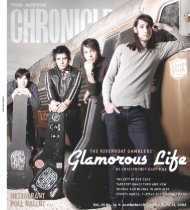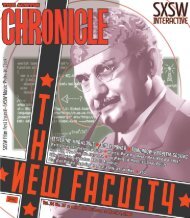Create successful ePaper yourself
Turn your PDF publications into a flip-book with our unique Google optimized e-Paper software.
screens44SPLIT DECISION<strong>The</strong> film community gathers to discuss the future of <strong>Austin</strong> StudiosBY RICHARD WHITTAK ERSo the <strong>Austin</strong> Film Society is staying at <strong>Austin</strong>Studios through 2042. Next step: Explaining their longtermplans. With the green screen of stage three attheir backs, roughly 100 attendees at the June 25public forum at <strong>Austin</strong> Studios were walked throughthe newly signed contract with the city, which extendsAFS’ current lease at the site after 2012 for 30 moreyears, and the resulting facilities plan. As was expected,controversy erupted over the proposed five-yearsubletting of stage four to Nashville-based Soundcheck<strong>Austin</strong>. <strong>The</strong> proposed $975,000 renovation ($500,000coming from Soundcheck, $475,000 via AFS from alow-interest loan to be paid off by Soundcheck’s rent)would convert that space into six soundproofedrehearsal studios and eight vendor offices.Board member Travis White explained, “One of thefactors is trying to keep AFS viable.” <strong>The</strong> stage hasbeen empty for the last year, and AFS has had to dipinto its fund reserves for the last two years to covershortfalls. If Soundcheck did move in, not only wouldthe stage produce more revenue annually than everbefore, but it would provide on-site sound facilities and potentiallyattract more music videos and behind-the-scenes-style productions.AFS staff countered fears that the deal means losingmill space for set construction, as the new contract with the cityrelaxes the restrictions on erecting new structures. As for anylost stage square footage, that would be restored in 2012 whenthe studio takes over the neighboring National Guard armory.Attendees were split about the stage four proposal, and tempersoccasionally flared. Some in the film community voiced concernsthat it moved the studio and AFS away from their core mission.From the music community, representatives of <strong>Austin</strong>-basedrehearsal facility Music Lab questioned the impact of Soundcheckon their business. Others took potshots at AFS and its decisionmakingprocess, with Jay Podolnick (CEO of abortive mixed film‘And Here’s the Kicker’ 45 TV Eye 68 Film Listingsand music production facility/housing development Villa Muse)calling it “like the Vatican, where you make up your own rules.”AFS Board President Chris Adams said he understood thestrength of the concerns. “I think that the economy has hurt alot of people,” he said. With the revised Texas Moving ImageIndustry Incentive Program, some fear reduced studio space willmean turning away major productions, but the studio has yet tosee any increase in inquiries, and the terms of the new bill areintended to promote small-scale productions and video gamedesign, not just features.<strong>The</strong> big message from AFS to the attendees was that the subleaseis not a done deal. Due to the scale of the improvements,it has to go back to council, and AFS still welcomes other proposals.“If anyone wants to rent stage four,” said Director ofOperations Catherine Parrington, “call me.”CONTRACTING AND EXPANDING AT KLRU<strong>The</strong> lights go out on KLRU2 as a new channel takes the stageBY BELINDA ACO STA<strong>The</strong> sour economy forced local PBS affiliateKLRU to make some hard changes lastMay. Reduced overnight hours, staff layoffs,production suspended on certain locallyproduced programs, and some well-publicizedbehind-the-scenes union blues madethe future of <strong>Austin</strong>’s public television lookwobbly. While the dust has been settling inthe aftermath of layoffs and budget cuts,it’s not all business as usual at KLRU. Evenbefore the new reality of a troubled economy,a few innovations have been in theworks, and several more are on the horizon.<strong>The</strong> most visible change for many viewersis the elimination of KLRU2 (for TimeWarner Cable subscribers) and KLRU-G(for Grande Cable subscribers). AlthoughGrande subscribers saw KLRU-G disappearearlier in the week, the void was onlytemporary. Starting <strong>July</strong> 1, KLRU-G andKLRU2 have been replaced with KLRU-Q.JOHN ANDERSONThanks to the digital conversion, KLRU-Q,the public television station’s third multicastchannel, is available to noncable subscribers.KLRU-Q joins the “main” KLRUchannel and another pre-existing channelknown as KLRU Create (which emphasizescooking and craft shows) in part of anongoing effort “to experiment with programmingstrategies that more fully use the station’sexisting digital bandwidth,” saysKLRU General Manager Bill Stotesbery.While still in formation, the new KLRU-Q isdescribed as “an eclectic mix of PBS programsand other shows not seen onKLRU,” according to online press materials.Stotesbery continues: “We decided tobring up our third multicast channel, availableto everyone, to feature some programsnot seen on the other multicastchannels of special interest to <strong>Austin</strong>-areaaudiences.” Best of all, “the cost is nearlyRebecca Campbell, director at <strong>Austin</strong>Film Society, leads the <strong>Austin</strong> Studiosforum on June 25.zero,” Stotesbery says of the change, addingthat KLRU-Q will be programmed inblocks, with hopes of attracting new viewers,underwriters, and sponsors. Music, ablock called Tea Time (British comedies),drama, and reality are only a few bannersthat describe the aggregated programmingblocks that viewers can expect to view onthe Q.<strong>The</strong> children’s programming that manyparents have come to rely on will still becarried on the flagship KLRU channel.And while it’s too early to announce,Stotesbery said the station is activelylooking inside the KLRU vault to see whatoldies and goodies stand the test of timeto be brought back to the airwaves.As far as returning to a 24/7 format,Stotesbery hopes that will happen at theend of summer. “Maybe earlier. We’re notquite there technically,” he says.See our Screens blog, Picture in Picture, at austinchronicle.com/blog/pip for the new channel information for digital TV, Grande, and Time Warner customers.film newsBY JOE O ’CONNELLHORROR STORIES SCARE UP FUNFOR DAYTON, KENT<strong>Austin</strong> singer-songwriter Jesse Dayton may havestumbled onto a film career and a new musical identity.He and his band are Captain Clegg & the NightCreatures in Rob Zombie’s Halloween II (the sequelto his 2007 Halloween reimagining), which is due intheatres Aug. 28. Dayton says he met Zombie throughTexas actor Lew Temple, who played Adam Banjo inZombie’s 2005 film, <strong>The</strong> Devil’s Rejects. Dayton wasasked to write and record songs for that film’s soundtrack,which has developed quite a following amonghorror fans. Zombie ran into Dayton six months agoand asked him to write songs for his latest film. “Iimmediately started getting e-mails from Rob aboutsong ideas,” Dayton says, “then two weeks later hetells me he’s making another Halloween with HarveyWeinstein, and that’s the film we’re doing.” Soon hefound himself filming in a Civil War graveyard inGeorgia. “I always wanted to play a psychobilly vampirein a huge horror movie!” he says of the role. Ifyou saw a camera crew at the Continental Club recently,that was likely the video shoot for a Dayton songfrom the soundtrack, also due out Aug. 28 and to befollowed by a Captain Clegg tour… Horror fans maywant to stop by the release party at 7pm on <strong>July</strong> 15 atBookPeople for my pal Gary Kent’s memoir, Shadowsand Light: Journeys With Outlaws in RevolutionaryHollywood. Kent, a legendary stuntman/actor/writer/director who has worked with everyone from RichardRush (Hells Angels on Wheels) to Monte Hellman(Ride in the Whirlwind) to Al Adamson (Satan’sSadists), expects the crowd to include Bud Cardos(Kingdom of the Spiders), Chuck Bail (<strong>The</strong> Stunt Man),Don Jones (Schoolgirls in Chains), and Bob Ivy (whoplayed the mummy in Bubba Ho-Tep).AUSTIN FACES CROWD TXMPA BOARD<strong>Austin</strong> is well-represented on the latest TexasMotion Picture Alliance board, which was electedSaturday in San Marcos. At-large candidates CraigBerlin, Jeanette Scott, and Rick Olmos join centralregion rep Paul Alvarado-Dykstra on the board, andcentral region alternate Shelly Schriber was electedboard treasurer. Don Stokes of Dallas, who led thelobbying group’s efforts to expand the state’s filmincentives program, was re-elected president. <strong>The</strong> biggestnews may well be the election of Oge Young ofSony Online Entertainment as the film lobbying group’sfirst video game, animation, and visual effects rep.Why does all of this matter? Scott’s online letter toTXMPA members says it all: “I have spent the lastseveral months in Oklahoma, on a feature film set inTexas. We are filming here for one reason. Legislativeincentives. <strong>The</strong> Oklahoma state legislature has justsigned into law a bill granting a rebate of 38% to filmproductions, and believe me, the studios are lining upand salivating. Never mind that there is no crew base,no infrastructure, no soundstage, no office facilities.We are based in an abandoned department store. <strong>The</strong>toilets work intermittently. Next to my desk, the waterflows down the pipe each time someone flushes thetoilet. But the people are lovely, the locations aregood, and the community is eager & ready to build upthe crew base and infrastructure to make this a trulycompetitive destination.”a u s t i n c h r o n i c l e . c o m JULY 3, <strong>2009</strong> T H E A U S T I N C H R O N I C L E 43



